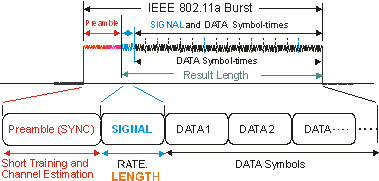Result Length (802.11a/g/j/p OFDM)
The parameter is used to specify the amount of acquired time data (in symbols) that is available for measurement analysis. For 802.11a/g/j/p OFDM Orthogonal Frequency Division Multiplexing: OFDM employs multiple overlapping radio frequency carriers, each operating at a carefully chosen frequency that is Orthogonal to the others, to produce a transmission scheme that supports higher bit rates due to parallel channel operation. OFDM is an alternative tranmission scheme to DSSS and FHSS. analysis, the Result Length data includes the Payload Data symbols starting at the first Data symbol after preamble within the measurement burst. There are two Result Length modes: Automatic mode and Manual mode. In "Automatic" mode the VSA automatically limits the maximum result length (which also limits the Measurement Interval) to the measurement burst length. In "Manual" mode the measurement result length and Measurement Interval can extend beyond the measurement burst length.
You use the Measurement Interval and Measurement Offset parameters to specify how much and what section of the Result Length that is included in measurement analysis.
|
In Automatic mode the VSA automatically limits the maximum measurement result length to the measurement burst length. This protects against including non-burst data in the measurement analysis. There are two Automatic mode Result Length conditions: 1) Result Length > Burst Length: 2) Result Length ≤ Burst Length |
|
| The VSA uses the specified Result Length as the maximum Result Length. All input data specified by the and parameters will be included in the measurement analysis even if the Measurement Interval includes data beyond the measurement burst. Care must be taken to not include unwanted symbols in the measurement analysis. |
Automatic vs. Manual Result Length modes
Example: The following figures show the difference between Automatic and Manual modes when the Results Length is greater than the measurement burst.

result length mode limits the data analysis to symbols within the burst length.mode does not limit the result length to the measurement burst. The VSA will demodulate the total number of symbols specified by Manual. Care must be taken to not include non-measurement symbol which could lead to unexpected and incorrect data results.
Return to Top of Page
Determining the Result Length (Automatic mode)
When is selected, the VSA compares the number of symbols transmitted within the burst, to the and uses the smaller value as the measurement result length. The method used to detect the number of data symbols within the burst is OFDM modulation format dependent.
-
For IEEE Institute of Electrical and Electronics Engineers. A US-based membership organisation that includes engineers, scientists, and students in electronics and related fields. The IEEE developed the 802 series wired and wireless LAN standards. Visit the IEEE at http://www.ieee.org 802.11a/g/j/p OFDM signals, the VSA uses the SIGNAL Symbol LENGTH data field to determine the number of DATA symbols within the burst. The Result Length is equal to the SIGNAL Symbol-time plus the DATA Symbol-times.
-
For HIPERLAN/2 OFDM signals, the VSA uses the detected pulse width to determine the number of data symbols within the burst.
OFDM IEEE 802.11a/g/j/p SIGNAL Symbol
The following figure shows the IEEE 802.11a/g/j/p OFDM burst structure, which contains the Preamble symbols followed by the SIGNAL symbol time and Data symbol times. The SIGNAL symbol contains the RATE and LENGTH fields. The VSA uses the LENGTH field to determine the number of DATA symbols within the burst. The encoding of the SIGNAL, single OFDM symbol, is performed with BPSK Binary phase shift keying - A type of phase modulation using 2 distinct carrier phases to signal ones and zeros. modulation of the subcarriers.

Return to Top of Page
See Also
